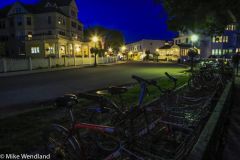Our Love Affair with Mackinac Island
For the better part of four decades, there is one place that has lured Jennifer and me back again and again, multiple times each year: Mackinac Island, located in Lake Huron, at the eastern end of the Straits of Mackinac, between the state’s Upper and Lower Peninsulas.
It’s a place where motor vehicles are prohibited and where RVs must be left on the mainland at the passenger ferry docks. On the island, the only transportation available is by walking, riding bicycles or by horse. Just 3.8 square miles in size, most of the place is a State Park and the hundreds of thousands of of tourists who visit each year come mostly during the summer, most visiting just for the day, although many others stay overnight at the island’s beautifully restored Victorian-styled hotels, luxury resorts and charming bed and breakfasts.
Mackinac Island has the distinction of being the second officially protected park by the federal government. In 1872 the Congress designated Yellowstone America’s first national park. In 1875 portions of federal land on Mackinac Island were given similar protection. This ensured the preservation of most of the natural limestone formations such as Skull Cave, Arch Rock and Sugar Loaf. Twenty years later, when the last U.S. army soldiers left Fort Mackinac, all federal land, including the fort, became Michigan’s first state park. The newly appointed Park Commission limited all private development in the park and required leaseholders to maintain the distinctive Victorian architecture of their bluff cottages. In recent years the historical sites and fort buildings such as the Officers’ Stone Quarters have been restored to their original condition and brought to life through dioramas, period settings, guided tours and reenactments for the benefit of the thousands of summer visitors.
We usually overnight. We love the Grand Hotel, at the start of the western bluff, dubbed “America’s Summer Place” and consistently voted one of the top resort hotels in the world. It’s a place where you still must dress up for dinner. There’s High Tea in the lobby most afternoons and the hotel’s massive front porch overlooking the Straits is one of the most pleasant places you’ll find anywhere.
We also like Mission Point, a sprawling resort on the island’s eastern end.
What do we do there? We bike and hike. If it rains, we hole up in our room and read and nap.
It truly is a place to get away from it all.
There are lots of places to camp in and around the gateway cities of Mackinaw City on the lower peninsula side, and St. Ignace on the UP side. Our favorite mainland overnight spots are both state parks: Wilderness State Park west of Mackinaw City, and Straits State Park in St. Ignace. There are three ferry boat lines serving the island. We like Star Lines because their boats make the eight mile crossing to Mackinac Island in about 18 minutes, much faster than the other lines.
You can see from the photos why we like the place so much.
Here’s some history and details from the Mackinac Island website:
It was the Victorians who made Mackinac Island one of the nation’s most favored summer resorts. In the post-Civil War industrial age and before automobiles, vacationers traveled by large lake excursion boats from Buffalo, Cleveland, Chicago and Detroit to the cooler climes of Mackinac Island. They danced to Strauss’ waltzes, listened to Sousa’s stirring marches, dined on whitefish and strolled along the broad decks. To accommodate overnight guests boat and railroad companies built summer hotels, such as the Grand Hotel in the late 19th century. Victorians, like travelers everywhere, shopped for souvenirs, and Mackinac shops supplied them.
In the 1890’s wealthy Midwestern industrialists who wanted to spent more than a few nights on Mackinac built their own summer cottages on the east and west bluffs. Soon a social life including tennis, hiking, bicycling, examining the local natural wonders, and at the turn of the century, golf at on the new Wawashkamo Golf Course.
Location has determined much of Mackinac Island’s history. Eleven thousand years ago in prehistoric times, not long after the retreat of the last glacier, aboriginal natives stood on the mainland shore, looked out over the Straits between two newly formed great lakes and saw an island with unusually high bluffs. They thought it resembled a large reptile and called it mish-la-mack-in-naw or big turtle. When they explored it, they marveled at its unusual natural limestone formations and buried their dead in the Island’s caves.
French-Canadian courieur de bois Jean Nicolet is believed to be the first white man to see Mackinac during his explorations on behalf of Samuel de Champlain, governor of Canada, in 1634.
The Jesuit Jacques Marquette preached to the Straits Indians in 1671 and soon after the area became the most important French western fur trade site. After the British acquired the Straits following the French and Indian War, the English Major Patrick Sinclair chose those high bluffs for the site of his Fort Mackinac in 1780.
The Americans never threatened the British fort during the American Revolution and following the revolution obtained the Straits area by treaty. However, problems with the British in nearby Canada led to the War of 1812. In July of 1812 a British force landed secretly on the far north end of Mackinac Island and forced the United States to surrender Fort Mackinac in the first engagement of that conflict. There were no casualties.
In 1814 the Americans attempted to regain the Island by also approaching from the north, but failed to defeat the British who in the meantime had fortified the high ground behind Fort Mackinac. The British and Americans fought the battle in the vicinity of the present day site of the Wawashkamo Golf Course. The British fortification was renamed Fort Holmes in honor of Major Andrew Hunter Holmes, a young American officer who died in the conflict. In 1815 the Island was restored once again to the Americans by treaty.
After the War of 1812 Mackinac Island became the center of John Jacob Astor’s American Fur Company. For the next thirty years the German immigrant provided beaver pelts for the beaver hats so favored by contemporary Jane Austen’s dashing young men.
In 1822 Fort Mackinac’s post surgeon William Beaumont saved the life of Alexis St. Martin after an accidental shotgun blast tore a hole in the young voyageur’s stomach. When the hole never completely healed, the physician observed first hand what happens when food is digested in the stomach. His published experiments made medical history.
In the 1860s Mackinac Island processed barrels of whitefish and lake trout destined for eastern markets. Each spring local Irish fishermen, coopers, net makers and dray men cleaned, salted, dried and packed the succulent fish which were carried on lake boats to Canadian and New York markets. This thriving industry replaced Astor’s diminishing fur trade which had now moved to the northwest states.
Is romance in your soul? Welcome to Mackinac Island. It was inevitable that 19th century writers would discover the Island’s charm, but even before the written word, Indian legends were part of its history. For many native Americans Arch Rock was created when a beautiful Indian maiden’s tears washed away the limestone bluff as she waited in vain for her lover to return.
In the 1820s a young army lieutenant on a tour of duty at Fort Mackinac sat on the porch of the Officers’ Stone Quarters and composed beautiful letters to his wife revealing his loneliness and love for her. During the Civil War, John C. Pemberton, now a general, commanded a Confederate army in Tennessee and had the dubious distinction of surrendering Vicksburg to U.S. Grant.
New England poet Henry Longfellow based his long narrative poem, in part, on written accounts of Henry R. Schoolcraft, an Indian agent who recorded information on Indian legends and culture while residing at Mackinac’s Indian Dormitory during the 1830s.
Edward Everett Hale wrote his”Man Without a Country” while sitting on the porch of the Mission House.
In the late 1880s Constance Fenimore Woolson, a popular novelist and close friend of Henry James, wrote her best-known book, Anne, which is the story of a young girl and her exciting adventures on Mackinac Island. Anne’s Tablet on the Fort bluff commemorates Woolson, as does nearby Anne Cottage.
Mark Twain, on an international tour to recoup his fortunes, visited Mackinac during July 1895 and lectured at Grand Hotel. According to his memoirs, Twain was paid $345 for this speaking engagement.
In 1946 after World War II MGM filmed a romantic tale of lost and found love called, This Time for Keeps starring the famous swimmer Esther Williams and Jimmy Durante.
In 1979 the Grand was again the setting for a romantic fantasy called Somewhere in Time, starring Christopher Reeve and Jane Seymour. Each fall the hotel hosts a reunion of fans enchanted by the movie. But love is celebrated by ordinary folks, too. Each Saturday from June to September the island hosts several weddings.
Though most resorts and hotels shut down during the winter, there is always at least one hotel open. The Arnold Line ferry only runs from St. Ignace during the beginning of the winter season. They run a daily schedule to the island until the Straits freeze over. Flights to the island from the Mackinac County Airport in St. Ignace are available through Great Lakes Air for $21 one way per person.
If it’s a really cold winter and the straits are frozen over, brave locals mark an “ice bridge” with Christmas trees from St. Ignace to the island and traverse it all winter long by snowmobiles.

















0 Comments
Recommended Comments
There are no comments to display.
Please sign in to comment
You will be able to leave a comment after signing in
Sign In Now